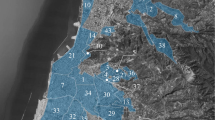Abstract
The definition of the relationship between the actual flow delivered by a node of a water distribution network and the available nodal pressure head is one of most crucial problems in Pressure Driven Analysis (PDA). The paper proposes a procedure, based on two models (building model and supplied urban area model), by means of which it is possible to generate and to simulate numerous different scenarios regarding the water delivery in the urban area supplied by a distribution network node. The scenarios are achieved by reproducing, through appropriate random generators, several urban and hydraulic situations, which are defined by various parameters governing water delivery. The statistical processing of the simulation results allows to define a representative pressure-flow relationship which reproduces, on average, the complex and varied set of phenomena governing the actual water delivery. Two application examples are also presented; the results of these study cases allow to calibrate the Tanyimboh and Templeman (2010) relationship, which is good for incorporation in PDA algorithms, because it is continuous with its first order derivatives in the whole field of pressure head values.




Similar content being viewed by others
References
Ang WK, Jowitt PW (2006) Solution for water distribution systems under pressure-deficient conditions. J Water Resour Plan Manag 132(3):175–182
Bhave PR (1981) Node flow analysis of water distribution systems. J Transp Eng 107(4):457–467
Chandapillai J (1991) Realistic simulation of water distribution system. J Transp Eng 117(2):258–263
Cheung PB, Van Zyl JE, Reis LFR (2005) Extension of EPANET for pressure driven demand modeling in water distribution system, International Conference on Computing and Control in the Water Industry “ Water Management for the 21st century, University of Exeter, UK
Ciaponi C. (2009), Performance analysis in water supply. Performance indicators for the planning design and management of water supply systems (Editor C. Ciaponi), CSDU, Milano, ISBN/ISSN: 978-88-903223-0-3
Ciaponi C, Franchioli L, Papiri S (2012) Simplified procedure for water distribution networks reliability assessment. J Water Resour Plan Manag 138(4):368–376
Fujiwara O, Ganesharajah T (1993) Reliability assessment of water supply systems with storage and distribution networks. Water Resour Res 29(8):2917–2924
Fujiwara O, Li J (1998) Reliability analysis of water distribution networks in consideration of equity, redistribution and pressure-dependent demand. Water Resour Res 34(7):1843–1850
Gargano R, Pianese D (2000) Reliability as tool for hydraulic network planning. J Hydraul Eng 126(5):354–364
Germanopoulos G (1985) A technical note on the inclusion of pressure dependent demand and leakage terms in water supply network models. Civ Eng Syst 2(3):171–179
Giustolisi O, Walski TM (2012) Demand component in water distribution network analysis. J Water Resour Plan Manag 138(4):356–367
Giustolisi O, Kapelan Z, Savic D (2008a) Algorithm for automatic detection of topological changes in water distribution networks. J Hydraul Eng 134(4):435–446
Giustolisi O, Savic D, Kapelan Z (2008b) Pressure-driven demand and leakage simulation for water distribution networks. J Hydraul Eng 134(5):626–635
Gupta R, Bhave PR (1994) Reliability analysis of water distribution systems. J Environ Eng 120(2):447–461
Gupta R, Bhave PR (1996) Comparison of methods for predicting deficient-network performance. J Water Resour Plan Manag 122(3):214–217
Jowitt PW, Xu C (1993) Predicting pipe failure effects in water distribution networks. J Water Resour Plan Manag 119(1):18–31
Jun L, Guoping Y (2013) Iterative methodology of pressure-dependent demand based on EPANET for pressure-deficient water distribution analysis. J Water Resour Plan Manag 139(1):34–44
Kalungi P, Tanyimboh T (2003) Redundancy model for water distribution systems. Reliab Eng Syst Saf 82(3):275–286
Kovalenko Y, Gorev NB, Kodzhespirova IF, Prokhorov E, Trapaga G (2014) Convergence of a hydraulic solver with pressure-dependent demands. Water Resour Manag 28(4):1013–1031
Liserra T, Maglionico M, Ciriello V, Di Federico V (2014) Evaluation of reliability indicators for WDNs with demand-driven and pressure-driven models. Water Resour Manag 28(5):1201–1217
Ozger SS, Mays LW (2003) A semi-pressure driven approach to reliability assessment of water distribution networks, Proceedings of the Thirtieth Congress, International Association of Hydraulic Research, Thessaloniki, Greece
Siew C, Tanyimboh TT (2012) Pressure-dependent EPANET Extension. Water Resour Manag 26(6):1477–1498
Tabesh M, Asadiyani Yekta AH, Burrow R (2009) An integrated model to evaluate losses in water distribution systems. Water Resour Manag 23(3):477–492
Tanyimboh TT, Templeman AB (2010) Seamless pressure-deficient water distribution system model. Journal of Water Management ICE 163(8):389–396
Tanyimboh TT, Burd R, Burrow R, Tabesh M (1999) Modelling and reliability analysis of water distribution systems. Water Sci Technol 39(4):249–255
Todini E (2003) A more realistic approach to the “Extended Period Simulation” of Water Distribution Networks, Proc., 2003, Advances in Water Supply Management, C. Maksimovic, D. Butler, and F.A. Memon, editors, A A Balkema Publishers, Lisse (the Netherland), ISBN: 9058096084, pp. 173–184
Todini E, Pilati S (1988) A gradient method for the solution of looped pipe networks, in Computer applications in water supply: Vol. 1- Systems analysis and simulation (B. Coulbeck and C.M. Orr editors), John Wiley & Sons, pp.1–20
Tucciarelli T, Criminisi A, Termini D (1999) Leak analysis in pipeline system by means of optimal valve regulation. J Hydraul Eng 125(3):277–285
Wagner JM, Shamir U, Marks DH (1988) Water distribution reliability: simulation methods. Journal of Resources Planning and Management 114(3):276–294
Walski TM, Bezts W, Posluszny E, Weir M, Whitman BE (2006) Modelling leakage reduction through pressure control. J Am Water Works Assoc 98(4):147–155
Wu ZY, Wang RH, Walski TM, Yang SY, Bowdler D, Baggett CC (2009) Extended global-gradient algorithm for pressure-dependent water distribution analysis. J Water Resour Plan Manag 135(1):13–22
Author information
Authors and Affiliations
Corresponding author
Rights and permissions
About this article
Cite this article
Ciaponi, C., Franchioli, L., Murari, E. et al. Procedure for Defining a Pressure-Outflow Relationship Regarding Indoor Demands in Pressure-Driven Analysis of Water Distribution Networks. Water Resour Manage 29, 817–832 (2015). https://doi.org/10.1007/s11269-014-0845-2
Received:
Accepted:
Published:
Issue Date:
DOI: https://doi.org/10.1007/s11269-014-0845-2



